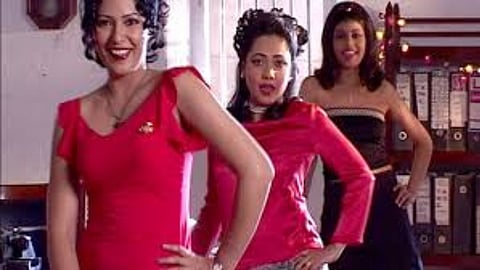
- HOMEGROWN WORLD
- #HGCREATORS
- #HGEXPLORE
- #HGVOICES
- #HGSHOP
- CAREERS
- ABOUT US
- CONTACT US

“Unlike the girl who got the guy, her eyes were always shining. Not with tears. She seemed always ready for a laugh; a song; a good time. They told me her name was Sandra.” (Where's Sandra, 2005)
Not just any Sandra — this line from Paromita Vohra’s 2005 Documentary ‘Where’s Sandra’ is a search to find and understand 'Sandra from Bandra'. Sandra from Bandra was a term used in the early 2000s to describe the 'racy', Christian girl living in Bandra; who wears a dress and likes to be jolly.
The Catholic community in Bandra has existed since the Portuguese Rule in the 1530s, and the quintessential Bandra girl was typically fluent in English, was convent-educated, and often had successful careers. Sandra from Bandra became a part of a culture that fetishised and sexualized women who were supposedly free from society’s restrictions.
“The Bandra girl got more westernised. Many of them were among the first to enter the workforce. This connotation, as seen in Sandra from Bandra, suggested that they were, in a way, inclined to socialise, and party, and were also fashion-conscious. They like music, and they like to dance. It all in a way, got encapsulated in this phrase, that Sandra from Bandra is a type of girl who characterised all of this,” says Ernest Fernandes, a resident of Bandra, in the documentary. All of these qualities strangely sound normal. So why was Sandra from Bandra more desirable? Was it her rebellion or religion? Was it the way she dressed? Or was it where she lived?
Bollywood’s party girl is a Sandra from Bandra, from Julie in Julie (1975) to Nancy from Baaton Baaton Mein (1979), storytellers have never shied away from depeciting their idea of Sandra from Bandra. For the Indian man, she was a sexual fantasy. She didn’t wear a saree, she laughed openly and talked easily. A leather jacket and a neat bike were all they needed to pick up a ‘Bandra chick’.
“People just tend to look at you as a Sandra from Bandra. Nothing else beyond that. That was your identity.”
Sandra Almedia, Resident of Bandra in 'Where’s Sandra'
Throughout the 18 minutes of the documentary, we encounter many Sandras — some from Mahim, some Punjabi, and some who are not Sandras, but are from Bandra. So who is Sandra from Bandra?
“It’s more of a feeling than being part of a community,” says Ritu Dewan, who is a proud Sandra from Bandra.
“There is a little bit of Sandra in all of us — In the girl who throws back her head and laughs; in the girl who rushes to catch the train to work and the girl who swishes her beautiful skirt as she dances,” says Vohra in an interview with BrainGain Magazine.
To the average man, Sandra from Bandra will remain a sexual fantasy. But to the rest of us, they will be the reason women can have careers and break past stereotypes. Maybe Sandra isn’t only from Bandra anymore.
If you enjoyed reading this, here's more from Homegrown:
The Story Behind Bandra’s Iconic Damian Store Christmas Displays
As Mumbai Bids Them Farewell, Trace The Iconic History Of Its Double-Decker Buses
